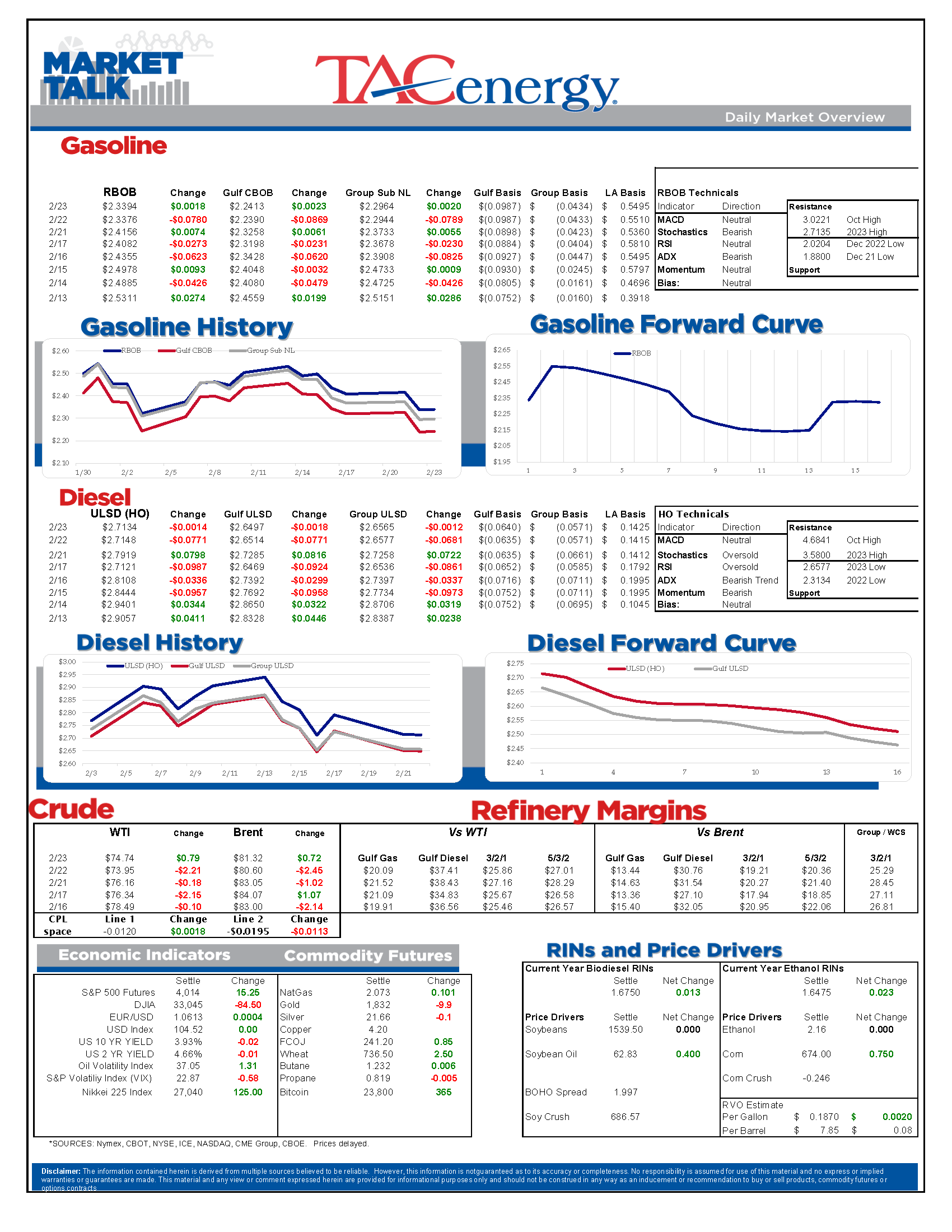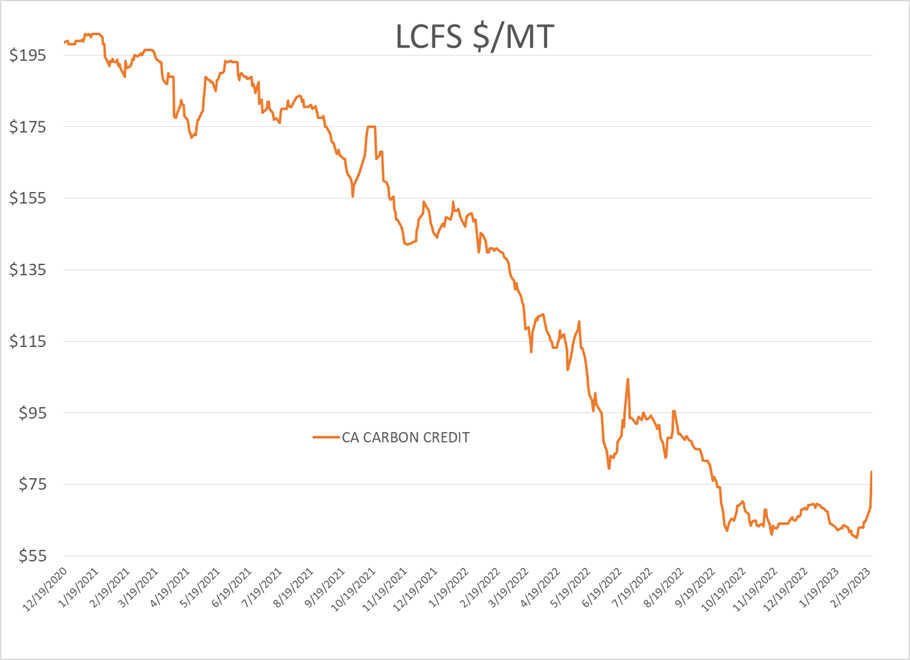ULSD Wiped Out The 8 Cent Gains From Tuesday

Energy contracts were trying to bounce to start Thursday’s session after another heavy wave of selling knocked them sharply lower on Wednesday and saw ULSD wipe out the 8 cent gains from Tuesday.
WTI has traded lower for 6 consecutive trading sessions, but still doesn’t look overly bearish on the charts, as it remains above the lows set in each of the prior 3 months. That said, the contract is “only” $5 away from setting new lows for the past year, and if the December support near $70 breaks, there’s not much on the charts to stop a slide to $62.
Russia is trying to stop the slide in oil prices, with reports suggesting plans to cut exports from Western ports by 25%, in excess of the already announced production cuts. The relative lack of reaction to that latest attempt to stir the oil pot is yet another sign of the weak market sentiment compared to a year ago when the war broke out.
ULSD still looks the most bearish on the charts, even though fundamentally there’s a strong argument that diesel stocks remain in the most precarious position. Even with today’s modest gains, ULSD prices are just 7 cents off of their lows for the past 12 months and if the $2.66 range fails to hold it looks like there’s a good chance, we’ll see a quick move towards $2.50.
The API reported another large build in US Crude stocks of nearly 10 million barrels last week, adding to last week’s estimate of a 10.5-million-barrel gain. The API’s figures seem to be catching up to the EIA’s data that showed stocks swelled by 16 million barrels last week as refiners cut runs due to heavy maintenance scheduled and numerous unplanned outages. The API also estimated small builds in gasoline and diesel inventories, in line with seasonal expectations. The EIA’s report is due out at 11am Eastern.
California’s LCFS credits spiked to a 6 month high this week after CARB suggested it would propose accelerating its emissions reduction targets this week to prop up prices that have come under steady selling pressure over the past 2 years thanks to a surge in renewables production. The $20 increase in credits this week adds roughly 2.5 cents/gallon to the cost of each gasoline and diesel (which create a deficit under the program) sold in the state but increases the value of Renewable Diesel by 10-13 cents/gallon depending on the CI value of the product.
California’s Cap and Trade program credits (CCAs) didn’t move on this news, as that program has a set credit amount, rather than a mechanism for renewable producers to create credits. The February CCA auction results are expected later this afternoon, which can be a market moving event depending on where prices settled out in the quarterly auction vs where they’ve been trading in the open market.
Click here to download a PDF of today's TACenergy Market Talk.
Latest Posts
Week 16 - US DOE Inventory Recap
Energy Markets Trading Quietly In The Red As Ethanol Prices Rally To Five-Month High
The Struggle For Renewable Producers Continues As A Rapid Influx Of Supply And Crashing Credit Prices Make Biodiesel
After Years Of Backwardation, Diesel Prices Have Slipped Into Contango Over The Past Week
Social Media
News & Views
View All
Week 16 - US DOE Inventory Recap

Energy Markets Trading Quietly In The Red As Ethanol Prices Rally To Five-Month High
Energy markets are trading quietly in the red to start Wednesday’s session after a healthy bounce Tuesday afternoon suggested the Israel-Iran-linked liquidation had finally run its course.
There are reports of more Ukrainian strikes on Russian energy assets overnight, but the sources are sketchy so far, and the market doesn’t seem to be reacting as if this is legitimate news.
Ethanol prices have rallied to a 5-month high this week as corn and other grain prices have rallied after the latest crop progress update highlighted risks to farmers this year, lower grain export expectations from Ukraine, and the approval of E15 blends this summer despite the fact it pollutes more. The rally in grain and renewables prices has also helped RIN values find a bid after it looked like they were about to test their 4-year lows last week.
The API reported small changes in refined product inventories last week, with gasoline stocks down about 600,000, while distillates were up 724,000. Crude oil inventories increased by 3.2 million barrels according to the industry-group estimates. The DOE’s weekly report is due out at its normal time this morning.
Total reported another upset at its Port Arthur refinery that’s been a frequent flier on the TCEQ alerts since the January deep freeze knocked it offline and damaged multiple operating units. This latest upset seems minor as the un-named unit impacted was returned to normal operations in under an hour. Gulf Coast basis markets have shrugged off most reports of refinery upsets this year as the region remains well supplied, and it’s unlikely we’ll see any impact from this news.
California conversely reacted in a big way to reports of an upset at Chevron’s El Segundo refinery outside of LA, with CARBOB basis values jumping by more than a dime. Energy News Today continued to show its value by reporting the upset before the flaring notice was even reported to area regulators, proving once again it’s ahead of the curve on refinery-related events. Another industry news outlet meanwhile struggled just to remember where the country’s largest diesel seller is located.
Click here to download a PDF of today's TACenergy Market Talk

The Struggle For Renewable Producers Continues As A Rapid Influx Of Supply And Crashing Credit Prices Make Biodiesel
The sigh of relief selloff continues in energy markets Tuesday morning, with gasoline prices now down more than 20 cents in 7 sessions, while diesel prices have dropped 26 cents in the past 12. Crude oil prices are within a few pennies of reaching a 1 month low as a lack of headlines from the world’s hot spots allows some reflection into the state of the world’s spare capacity for both oil and refined products.
Gasoline prices are trading near a 6-week low this morning, but still need to fall about another nickel in order to break the weekly trendline that pushed prices steadily higher since December. If that trend breaks, it will be safer to say that we saw the end of the spring gasoline rally on April 12th for the 2nd year in a row. Last year RBOB futures peaked on April 12 at $2.8943 and bottomed out on May 4th at $2.2500. The high (at this point) for this year was set on April 12th at $2.8516, and the low overnight was $2.6454.
It’s not just energy commodities that are seeing an unwind of the “flight to safety” trade: Gold prices had their biggest selloff in 2 years Monday and continue to point lower today. Just how much money poured into commodities in the weeks leading up to the direct confrontation between Israel and Iran is unclear, but we have seen in year’s past that these unwind-events can create a snowball effect as traders can be forced to sell to cover their margin calls.
Supply > Demand: The EIA this morning highlighted the record setting demand for natural gas in the US last year, which was not nearly enough to offset the glut of supply that forced prices to a record low in February. A shortage of natural gas in Europe was a key driver of the chaotic markets that smashed just about every record in 2022, and an excess of natural gas supply in Europe and the US this year is acting as a buffer, particularly on diesel prices.
The struggle for renewable producers continues as a rapid influx of supply and crashing credit prices make Biodiesel, RD and SAF unprofitable for many. In addition to the plant closures announced in the past 6 months, Vertex Energy reported Monday it’s operating its Renewable Diesel facility in Mobile AL at just 50% of capacity in Q1. The truly scary part for many is that the $1/gallon Blender's tax credit ends this year and is being replaced by the “Clean” Fuel production credit that forces producers to prove their emissions reductions in order to qualify for an increased subsidy. It’s impossible to say at this point how much the net reduction will be for domestic producers, but importers will get nothing, and at current CI values, many biodiesel producers may see their “blend credit” cut by more than half.
Click here to download a PDF of today's TACenergy Market Talk.


